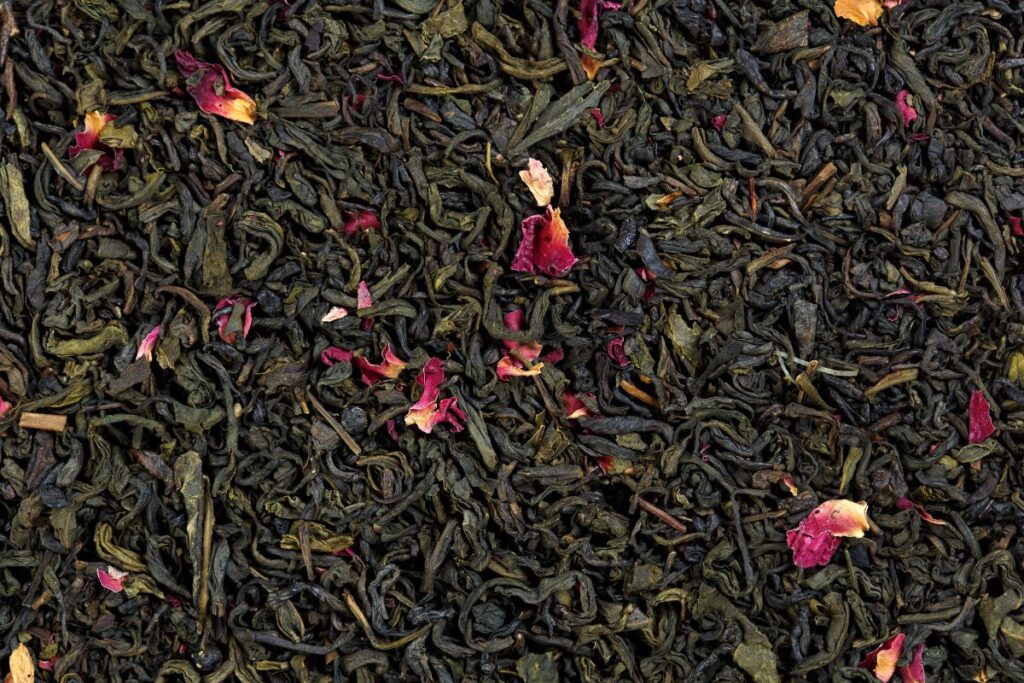Create Your Own Decaffeinated Tea Blends: A Step-by-Step Guide for DIY Tea Blending
Ever wondered how to enjoy a delicious cup of tea without the jitters or sleep disturbances caused by caffeine? Well, we’ve got just the solution for you. Creating your own decaffeinated tea blends at home not only allows you to tailor the flavors to your liking but also offers a range of benefits that will leave you feeling refreshed and satisfied.
With our easy-to-follow methods and a wide variety of ingredients at your disposal, you can become an artist in the art of blending decaffeinated teas. From fragrant jasmine pieces to fruity variations and comforting chai mixes, the possibilities are endless. And the best part? You can do it all from the comfort of your own kitchen.
Understanding the Basics of Tea Blending
Art and Science of Tea Blending
Tea blending is both an art and a science. It involves combining different types of teas to create unique flavor profiles and experiences. When we blend teas, we are not only experimenting with flavors but also exploring the chemistry behind how different components interact with each other.
Factors to Consider in Tea Blending
When creating our own decaffeinated tea blends, there are several factors we need to consider. One important factor is the flavor profile. We want to ensure that the flavors of the different teas complement each other and create a harmonious taste experience. For example, if we have a bold black tea as one component, we may want to balance it out with a lighter green or white tea.
Another consideration is the health benefits of the teas we choose to blend. Each type of tea has its own unique set of health benefits, whether it’s boosting metabolism, aiding digestion, or promoting relaxation. By blending different types of teas together, we can create blends that offer a range of health benefits.
Balancing Flavors and Aromas
In tea blending, finding the right balance of flavors and aromas is crucial. We don’t want any one component to overpower the others or for the final blend to be too bland or weak in taste. It’s like creating a symphony where each instrument contributes its own unique sound while harmonizing with the others.
To achieve this balance, we can experiment with different ratios of each tea component until we find what works best for our taste preferences. We can also consider adding complementary ingredients such as herbs, spices, or fruits to enhance certain flavors or aromas in our blends.
By understanding these basics of tea blending – the art and science behind it, considering flavor profiles and health benefits when selecting teas for our blends, and striving for balance in flavors and aromas – we can embark on a creative journey to create our own decaffeinated tea blends that are truly unique and tailored to our preferences.
Tea blending allows us to explore the vast world of teas, experiment with different combinations, and create blends that reflect our individual tastes and desires. So let’s grab our favorite teas, mix them together, and embark on a flavorful adventure!
DIY Decaffeination: Is It Possible?
Find out if it’s possible to decaffeinate tea leaves at home using simple methods.
When we think of tea, we often associate it with a comforting cup of warmth and relaxation. But what if you’re sensitive to caffeine or prefer to limit your intake? Is it possible to enjoy the flavor and ritual of tea without the stimulating effects of caffeine? Let’s explore the world of DIY decaffeination and find out!
Decaffeinating tea leaves at home is indeed possible, and there are a few simple methods you can try. One popular technique is called water processing, which involves steeping the tea leaves in hot water for a short period of time. The caffeine molecules will dissolve into the water, leaving behind flavorful but decaffeinated tea leaves. This method is relatively easy to do at home and doesn’t require any special equipment.
Another method that can be used for DIY decaffeination is carbon dioxide extraction. In this process, carbon dioxide gas is used to remove caffeine from the tea leaves. The gas acts as a solvent, bonding with the caffeine molecules and extracting them from the leaves. This method is more complex than water processing and typically requires specialized equipment.
Learn about the different techniques used to remove caffeine from tea leaves, including water processing and carbon dioxide extraction.
Water processing and carbon dioxide extraction are two common techniques used in commercial decaffeination processes as well. These methods have been refined over time to ensure maximum removal of caffeine while preserving the flavor profile of the tea.
In water processing, large batches of tea leaves are soaked in hot water for a specific amount of time. The water is then filtered through activated charcoal or other materials that selectively absorb caffeine molecules. Once filtered, the remaining liquid is reintroduced to the tea leaves so they can reabsorb some of their lost flavors before being dried.
Carbon dioxide extraction involves exposing moistened tea leaves to pressurized carbon dioxide gas. The gas acts as a solvent, extracting the caffeine from the leaves. After the extraction process, the carbon dioxide is depressurized, allowing it to evaporate and leaving behind decaffeinated tea leaves.
Discover the pros and cons of DIY decaffeination and its impact on flavor.
One of the main advantages of DIY decaffeination is that you have control over the process and can customize it to your preferences. You can choose which method to use, adjust steeping times, and experiment with different tea blends. DIY decaffeination also allows you to enjoy your favorite teas without compromising on taste.
However, there are some drawbacks to consider as well.
Getting Started with a Tea Blending Kit
If you’re ready to embark on your tea blending journey, a tea blending kit is the perfect starting point. This comprehensive kit provides everything you need to create your own decaffeinated tea blends right at home. Let’s explore the essential components of a tea blending kit and where you can find one that suits your preferences and budget.
The Essential Components of a Tea Blending Kit
A tea blending kit typically includes various tools and ingredients that are essential for creating unique and flavorful tea blends. One of the key components is a selection of high-quality tea bases. These can include black, green, white, or herbal teas, depending on your taste preferences. For those looking for a caffeine-free option, rooibos tea is an excellent choice as it offers a rich flavor profile without any caffeine content.
In addition to the tea base, a good blending kit will also provide measuring tools such as spoons or scoops to ensure accurate portions when mixing different ingredients. These tools are crucial in maintaining consistency and achieving desired flavors in your blends.
Storage containers are another important component of a tea blending kit. These containers help keep your blends fresh and prevent them from absorbing unwanted odors or moisture. Look for containers made from materials like glass or tin that offer an airtight seal to preserve the quality of your creations.
Lastly, flavoring ingredients play a vital role in adding depth and complexity to your decaffeinated tea blends. A variety of dried fruits, herbs, spices, and flowers can be included in the kit to experiment with different flavor combinations. It’s important to source these ingredients from reputable suppliers to ensure their freshness and quality.
Where to Find High-Quality Tea Blending Kits
There are several options available both online and in physical stores. Many specialty tea shops offer curated kits that cater specifically to different preferences and budgets. These kits often come with detailed instructions and recipe ideas to help you get started on your blending journey.
Online marketplaces and websites dedicated to tea enthusiasts also offer a wide range of tea blending kits. These platforms provide the convenience of browsing through various options from the comfort of your own home. They often feature customer reviews and ratings that can help guide your decision-making process.
Before purchasing a tea blending kit, it’s essential to research the reputation of the seller or brand. Look for reviews, testimonials, or recommendations from other tea enthusiasts to ensure you’re investing in a high-quality product.
Essential Tools for Successful Tea Blending at Home
Having the right tools is essential.
Scales
Accurate measurements are crucial when blending teas. Investing in a reliable kitchen scale allows us to measure the precise amount of each ingredient, ensuring consistency in flavor and strength. By weighing our tea leaves, herbs, spices, or rooibos, we can create the perfect balance of flavors in our blends.
Infusers
To extract the flavors from our tea leaves and other ingredients effectively, we need quality infusers. These handy tools come in various shapes and sizes, such as mesh balls or baskets. They allow us to steep our blend in hot water while keeping all the loose ingredients contained. Infusers make it easy to remove the leaves and prevent any unwanted debris from floating around in our cuppa.
Mixing Bowls
Mixing bowls are indispensable. They provide ample space to combine different types of pure teas or herbal teas with precision. Using dedicated mixing bowls for tea blending is important to avoid cross-contamination of flavors. We wouldn’t want rose petals from one blend mixing with another!
Aroma Cups
Aroma cups are not only aesthetically pleasing but also serve an important purpose in tea blending. These cups have a lid that helps capture and concentrate the aroma of the brewed tea within the cup itself. When we lift the lid and take a whiff of our creation, we can fully appreciate its aromatic qualities before sipping on it.
Tasting Sets
Tasting sets are an excellent addition to our tea blending toolkit. These sets typically include small cups or bowls that allow us to sample different blends side by side and compare their flavors. By using a tasting set, we can refine our blends and make adjustments to achieve the desired taste profile.
Tips for Creating a Good Tea Blend at Home
Uncover expert tips for creating a well-balanced and flavorful tea blend at home.
There are a few expert tips that can help you achieve the perfect balance of flavors. By following these tips, you’ll be able to create unique and delicious blends that suit your taste preferences.
One important tip is to experiment with different ratios of base teas, herbs, spices, and floral elements. This allows you to create a blend that has the desired flavor profile. For example, if you prefer a stronger tea flavor, you might want to use more black or green tea as the base. On the other hand, if you enjoy herbal notes, adding more herbs like chamomile or mint can enhance those flavors.
Learn how to experiment with different ratios of base teas, herbs, spices, and floral elements to achieve desired flavors.
To create a well-balanced blend, it’s essential to taste and adjust your mixture throughout the blending process. Start by brewing small samples of your blend using different proportions of ingredients. Take note of the flavors and aromas each sample produces. This will allow you to make adjustments until you achieve the perfect combination.
Don’t be afraid to get creative with your ingredients! Consider adding unexpected elements like dried fruit or citrus zest to add complexity and depth to your blend. Remember that experimentation is key in finding what works best for your taste buds.
Discover the significance of tasting and adjusting your blend throughout the blending process.
Tasting regularly during the blending process helps ensure that all the flavors are harmoniously balanced in your final product. It allows you to make necessary adjustments by adding more or less of certain ingredients until you reach an optimal flavor profile.
Keep in mind that some ingredients may have stronger flavors than others. For instance, certain spices like cinnamon or cloves can overpower other delicate flavors if used in excess. By tasting and adjusting as you go, you can avoid overpowering one ingredient with another.
Exploring Commercially Made Decaf Tea Options
Wide Range of Decaf Tea Options
There is a wide range of commercially made options available on the market. Whether you prefer black tea, green tea, herbal tea, or even iced tea, you can find decaf versions of your favorite blends. These teas undergo a special process to remove most of the caffeine content while retaining the flavor and aroma.
Decaffeination Methods and Flavor Impact
Tea companies use various methods to decaffeinate their teas, each with its own impact on flavor. One common method is the carbon dioxide (CO2) method, where pressurized CO2 is used to extract caffeine from the tea leaves. This method is known for preserving the natural flavors of the tea while removing caffeine.
Another popular decaffeination method is the ethyl acetate (EA) process. In this method, natural compounds found in fruits are used to extract caffeine from the tea leaves. While this process may alter the taste slightly, it still maintains much of the original flavor profile.
The third commonly used method is called water processing. With this method, hot water is used to remove caffeine from the tea leaves. Although it may result in a slight loss of flavor compared to other methods, many people appreciate its simplicity and minimal chemical intervention.
Choosing High-Quality Decaf Teas
When selecting decaf teas that meet our taste preferences and health needs, there are a few factors we should consider. First and foremost, it’s essential to choose high-quality teas made from premium ingredients. Look for teas that are sourced from reputable suppliers who prioritize quality control.
Pay attention to how the teas are processed after they have been decaffeinated. Some companies may add artificial flavors or chemicals during this stage which can affect both taste and health benefits. Opting for teas that go through minimal processing and contain only natural ingredients is a great way to ensure you’re getting the best possible cup of decaf tea.
Lastly, don’t be afraid to experiment with different brands and flavors. Each tea company has its own unique approach to decaffeination, resulting in variations in taste and aroma. By trying out different options, we can discover our personal favorites and find the perfect decaf teas that satisfy our cravings without the jolt of caffeine.
Step-by-Step Guide on How to Make Your Own Tea Blends
Follow a step-by-step guide to create your own decaffeinated tea blends from scratch.
Creating your own decaffeinated tea blends can be a fun and rewarding experience. By following a step-by-step guide, you can customize the flavors and ingredients to suit your preferences. Here’s how you can get started:
-
Gather Your Ingredients: Begin by selecting the types of teas, herbs, and spices that you want to include in your blend. Consider the flavors you enjoy and think about how different ingredients will complement each other.
-
Experiment with Ratios: Start by combining small amounts of each ingredient to test the flavor profile. Adjust the ratios until you achieve the desired taste. Remember that some ingredients may have stronger flavors than others, so it’s important to find the right balance.
-
Consider Health Benefits: While creating your blend, keep in mind the potential health benefits associated with certain teas, herbs, and spices. For example, chamomile is known for its calming properties, while ginger can aid digestion.
-
Properly Store Your Blend: Once you’ve created your perfect tea blend, it’s important to store it properly to maintain freshness and flavor. Use airtight containers that are stored away from direct sunlight and moisture.
-
Experiment with Steeping Times: Different blends may require different steeping times for optimal flavor extraction. Experiment with steeping times until you find what works best for your blend.
-
Share Your Creations: Don’t forget to share your homemade tea blends with friends and family! They might appreciate trying something new or even give you feedback on how they like it.
Learn how to select and combine different types of teas, herbs, and spices to achieve desired flavors.
When creating your own decaffeinated tea blends, it’s essential to understand how different ingredients contribute to the overall flavor. Here are some tips for selecting and combining teas, herbs, and spices:
-
Teas: Choose a base tea that you enjoy, such as black tea or green tea. Consider adding herbal teas like chamomile or mint for added depth of flavor.
-
Herbs: Herbs can add unique flavors and aromas to your blend. Experiment with lavender, rosemary, or lemongrass to create interesting combinations.
-
Spices: Spices can provide warmth and complexity to your blend. Cinnamon, ginger, cardamom, and cloves are popular choices that pair well with many teas.
Remember that the possibilities are endless.
Unique DIY Tea Blend Recipes to Try
Get inspired by unique DIY tea blend recipes that cater to various flavor profiles and health benefits.
Creating our own decaffeinated tea blends allows us to explore a world of flavors and customize our beverages according to our personal preferences. Whether we’re looking for soothing herbal blends, invigorating chai mixes, or refreshing fruity infusions, there are endless possibilities to try. Let’s dive into some unique DIY tea blend recipes that will surely tantalize our taste buds and provide us with an array of health benefits.
Soothing Herbal Blends
Herbal tea blends offer a calming and comforting experience, perfect for winding down after a long day or promoting relaxation. One delightful recipe to try is the “Chamomile Lavender Dream.” Combining dried chamomile flowers with fragrant lavender buds creates a soothing blend that helps alleviate stress and anxiety. Steeping this blend in hot water releases its floral aroma, transporting us to a state of tranquility.
Another fantastic option is the “Minty Fresh Delight.” This blend combines peppermint leaves with spearmint leaves for a refreshing and invigorating cup of tea. Peppermint aids digestion while spearmint provides a cooling sensation, making it an excellent choice after meals or during hot summer days.
Invigorating Chai Mixes
For those seeking bold flavors and an energizing kick, chai mixes are the way to go. One popular recipe is the “Spiced Masala Chai.” This traditional Indian beverage combines black tea leaves with spices like cinnamon, cardamom, ginger, cloves, and black pepper. The result is a rich and aromatic brew that warms both body and soul. Adding milk and sweetener enhances its creaminess and sweetness.
If we prefer something different but equally invigorating, we can try the “Matcha Ginger Zing.” Matcha green tea powder is combined with grated ginger for a unique blend that provides a burst of energy and aids digestion. The vibrant green color and earthy flavor of matcha, paired with the spiciness of ginger, create a harmonious balance that awakens our senses.
Refreshing Fruity Infusions
When we crave something light and refreshing, fruity infusions are the perfect choice. One delightful recipe to try is the “Berry Blast Medley.” Combining dried berries like strawberries, blueberries, and raspberries creates a vibrant blend bursting with antioxidants. This infusion can be enjoyed hot or cold, making it an excellent option for any time of the year.
Another option is the “Citrus Splash Surprise.
Documenting and Refining Your Tea Blend Creations
Importance of Documenting Tea Blend Creations
One thing we’ve learned is the importance of documenting our recipes. By keeping track of the ingredients we use, steeping times, and tasting notes, we can easily recreate our favorite blends in the future. Documenting also allows us to experiment with different combinations and make adjustments based on personal preferences.
Methods for Keeping Track of Blends
To ensure that our tea blend creations are well-documented, we have found a few helpful methods. One option is to keep a physical journal dedicated to our tea blending adventures. In this journal, we write down the specific ingredients used in each blend, along with their measurements. We also note the steeping time and any additional steps or techniques employed during brewing.
Another method that works well for us is using a digital note-taking app or spreadsheet. With these tools, we can easily organize and update our tea blend recipes as needed. We create separate tabs or folders for different types of blends (such as herbal or black tea blends) and include columns for ingredients, quantities, steeping times, and tasting notes.
Refining Your Tea Blends Over Time
Creating unique tea blends is an ongoing process, and refining them over time is essential to achieving the perfect flavor profiles. One way we refine our blends is by seeking feedback from friends and family who try them. Their input helps us identify areas where adjustments may be needed.
We also pay attention to our own taste preferences when refining our tea blends. By taking note of what flavors we enjoy most and which ones could be enhanced or balanced better, we can make informed decisions about adjusting ingredient ratios or experimenting with new flavors altogether.
Researching different brewing techniques specific to each type of tea allows us to optimize the flavor extraction process. For example, white teas may require lower water temperatures and shorter steeping times compared to black teas. By understanding the nuances of brewing different types of tea, we can refine our blends accordingly.
Conclusion
We’ve reached the end of our tea blending adventure, and what a journey it has been! From understanding the basics of tea blending to exploring DIY decaffeination methods, we’ve learned how to create our own unique tea blends right at home. Armed with essential tools and tips, we’ve discovered the joy of experimenting with different flavors and creating personalized teas that suit our taste preferences.
But our tea blending adventure doesn’t have to end here. We encourage you to continue exploring and refining your tea blend creations. Document your recipes, make adjustments, and share your blends with friends and family. Who knows, you might even start your own tea blending community or turn it into a small business venture!
So grab your tea blending kit, gather your favorite ingredients, and let your creativity flow. The world of tea blending is yours to explore and enjoy. Cheers to endless cups of delicious, homemade tea!
Frequently Asked Questions
Can I create my own decaffeinated tea blends at home?
Yes, you can! By understanding the basics of tea blending and using DIY decaffeination methods, you can create your own decaf tea blends right in your kitchen. With a tea blending kit and essential tools, you’ll be on your way to crafting unique blends that suit your taste preferences.
How do I get started with tea blending at home?
To get started with tea blending at home, you’ll need a tea blending kit which includes various teas and herbs. Gather essential tools such as measuring spoons, a scale, and storage containers. Follow step-by-step guides and experiment with different combinations to create your perfect blend.
Is it possible to make decaf tea at home?
Absolutely! While commercial decaf teas are available, you can also make your own decaffeinated tea at home by using methods like the water process or CO2 extraction. These processes help remove most of the caffeine while preserving the flavor of the tea leaves.
What are some tips for creating a good homemade tea blend?
When creating a homemade tea blend, start with quality ingredients like loose leaf teas and dried herbs. Experiment with different ratios and combinations to find the right balance of flavors. Consider factors like aroma, color, and taste when refining your blend. Don’t be afraid to think outside the box!
Are there commercially made decaf teas available?
Yes, there are several commercially made decaf teas available in the market. These products undergo industrial processes to remove caffeine while maintaining their flavor profiles. Exploring these options can provide inspiration for creating your own unique blends.




